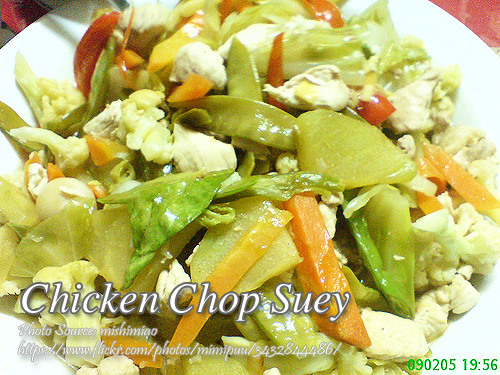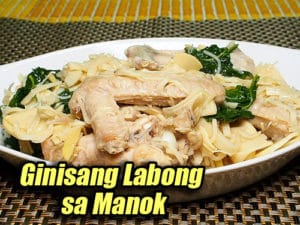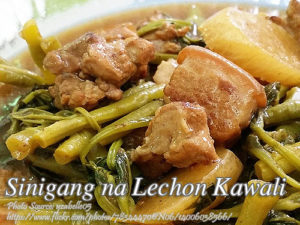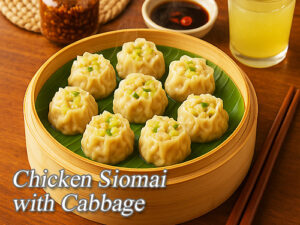If you are looking for a meaty chop suey, then this chicken chop suey is perfect for your taste. Aside from the usual vegetables used in this dish like the Chinese cabbage, cauliflower, carrots, it also contains water chestnuts, bamboo shoots, mushrooms, chicken, ham and pork slices.
Chicken Chop Suey: A Classic Filipino-style Stir-fry Loaded with Flavor
When I was a kid, my Tita Lita from Bacoor used to cook a big kawali of chicken chop suey every Sunday after Mass. She had this rule that everyone in the house—no matter how sleepy or full from merienda—had to sit down and eat together. Her version of the dish was packed, overflowing with all kinds of vegetables and tender chicken strips, and she’d always say, “Chop suey is the kind of meal where nothing gets left behind.”
Now that I make it in my own kitchen, I stick to her style—simple but full of flavor, and perfect for feeding a crowd. It’s one of those dishes that tastes even better the next day, once everything has soaked up all the good stuff.
Why This Stir-Fried Chicken and Veggie Dish Works
The beauty of a stir-fried vegetable and chicken medley like this is the contrast in texture and flavor. You get the crunch from cauliflower and carrots, the earthiness from mushrooms, and that mild sweetness from cabbage. Chicken makes it hearty without being heavy.
What makes this recipe shine is the layering technique. First, frying the chicken and pork slices in hot fat seals in the juices and creates a savory base. Adding aromatics like onions and celery early on brings out their flavors, while soy sauce deepens the umami profile. Finishing the dish with cabbage and green onions at the last minute keeps them crisp and fresh.
I learned this trick from my Uncle Bert, who used to run a small karinderya in Tarlac. He’d always say, “Cook the hardest vegetables first, softest ones last. Otherwise, you’re just making mush.” And he was right.
A Taste of Home and History
Chicken chop suey may seem like a foreign dish at first glance—its roots trace back to Chinese-American cuisine—but in the Philippines, we’ve embraced it and made it our own. You’ll find it at birthdays, fiestas, even on the table during noche buena, sitting proudly beside the lechon.
The name “chop suey” actually comes from the Cantonese words tsap seui, meaning “miscellaneous leftovers.” It was born out of practicality—throwing together whatever meats and vegetables were on hand. Here in the Philippines, we’ve adapted that to our local tastes, using ingredients like ham, bamboo shoots, and water chestnuts, which add a unique texture that Filipinos love.
When my cousin Angie visited from Iloilo last year, she made her version with smoked chicken and baby corn. It was different, but still delicious. That’s the magic of this dish—there’s room to play, and no two versions are ever quite the same.
How to Make Chicken Chop Suey for Beginners
Start with frying your chicken and pork in hot shortening. I know shortening might sound old-school, but it gives a richness that oil doesn’t quite replicate. You just want to lightly brown the meat to build flavor.
Once that’s done, toss in onions, ham, mushrooms, and celery. Stir-fry for a few minutes until everything is fragrant and slightly softened. At this stage, you’re layering flavor—it’s not just about cooking, it’s about building a base that everything else will cling to.
Then add soy sauce, water chestnuts, bamboo shoots, cauliflower, and carrots. Don’t be tempted to dump everything in at once; timing is key. The carrots and cauliflower need a bit more time to cook, and adding them now ensures they’ll be tender but not soggy.
Pour in a cup of stock—chicken or pork will both work—and let the dish simmer gently. This step helps the flavors meld and softens the vegetables even further.
When the cauliflower is just about done, stir in a cornstarch paste to thicken the sauce. Let it simmer for about five minutes until glossy. Finally, right before serving, toss in shredded cabbage and green onions for that final burst of freshness.
Serving Suggestions and Final Tips
This stir-fried chicken and vegetable favorite is best served hot with a big bowl of steamed rice—ideally sinangag if you’re eating leftovers the next day.
If you want to make it even more special, add a dash of sesame oil at the end or top it with toasted garlic. And remember, don’t skip the bamboo shoots and water chestnuts—they give the dish that signature crunch and subtle flavor that takes it from simple to special.
So the next time you’re looking for a complete, comforting meal in one pot, try this chicken chop suey. It’s humble, hearty, and full of the kind of flavor that brings people together—just like it did every Sunday in Tita Lita’s kitchen.
How to Cook Chicken Chop Suey
Ingredients
- 1/2 kilo chicken cut up
- 1/2 cup shortening
- 1 cup ham slices optional
- 1/4 kilo pork slices
- 1 cup red and green pepper bells diced
- 1/4 cup soy sauce
- Salt and pepper to taste
- 2 tablespoon cornstarch dissolved in 1/4 cup water
- 1/2 cup mushrooms soaked in water
- 1/2 cup bamboo shoots sliced
- 1/2 cup water chestnuts sliced
- 1/2 cup carrot
- 1 cup cauliflower
- 1 cup Chinese cabbage shredded
- 1/2 pc green onions cut 5 cm. long
- 1 cup stock or water
Instructions
How to cook Chicken Chop Suey:
- Fry chicken and pork slices in hot shortening.
- Add onions, ham, mushrooms and celery. Pan-fry a few minutes.
- Then add soy sauce, chestnuts,bamboo shoots, cauliflower, and carrots.
- Add 1 cup stock and cook a few minutes more or until cauliflower is done.
- Add the cornstarch paste and simmer for about 5 minutes.
- A few minutes before serving, add shredded cabbage and cut green onions.
- Add more soy sauce and seasonings as desired. Serve hot. Good for 6 persons.
Notes
Cooking Tips:
Cut Ingredients Uniformly for Even Cooking
Chop all your vegetables and meats into similar-sized pieces to ensure they cook evenly. This helps prevent some veggies from turning mushy while others stay undercooked. Uniform cuts also give the dish a cleaner, more appetizing look on the plate.Cook Hard Veggies First, Soft Ones Last
Start by stir-frying the denser vegetables like carrots and cauliflower before adding quicker-cooking ones like cabbage and green onions. This keeps each component at its ideal texture and prevents the softer veggies from breaking down too soon. Timing the layering makes a big difference in both taste and presentation.Don’t Skip the Cornstarch Slurry
A cornstarch and water mixture added toward the end creates that glossy, slightly thick sauce that clings beautifully to every bite. It pulls all the flavors together and gives the dish that restaurant-style finish. Just make sure to stir the slurry again before pouring, as cornstarch tends to settle at the bottom.




